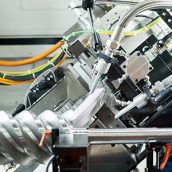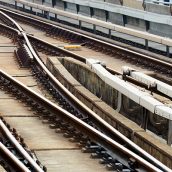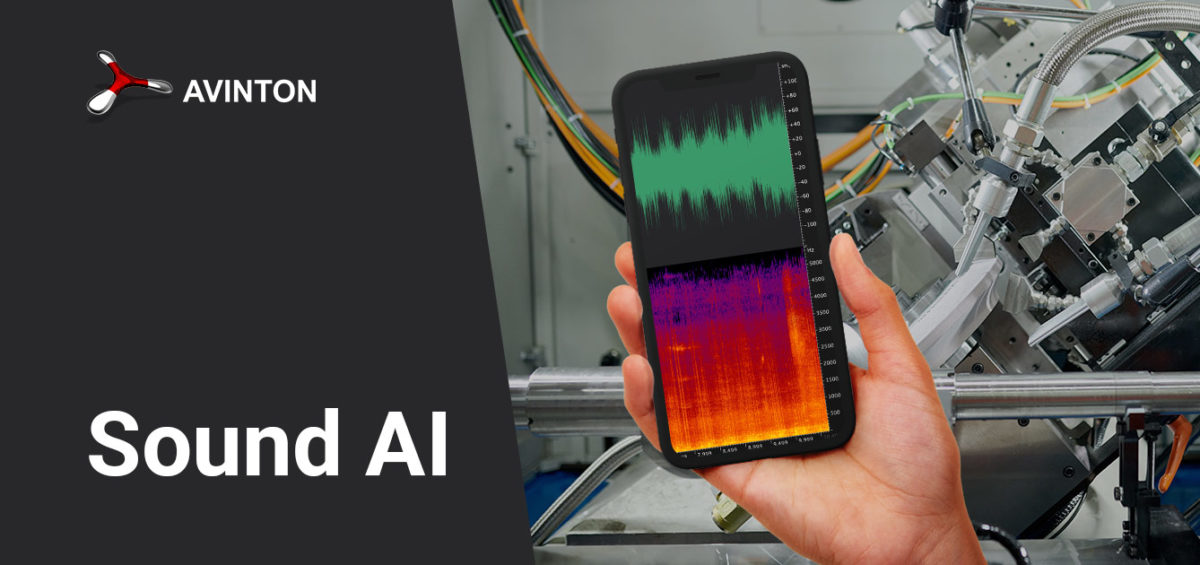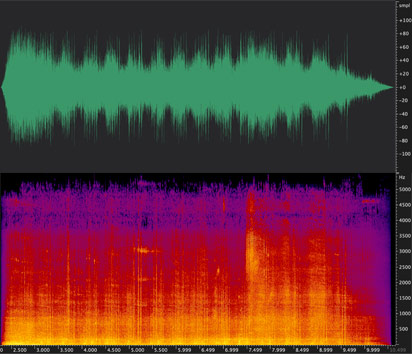Table of Contents
What if we could predict failure before it actually happens? In this article, we introduce Sound AI and highlight its potential for the manufacturing and automotive industries, railway companies and power plants. Learn how our fully customizable solution makes predictive maintenance a reality.
Key Take-Aways
- When it comes to ensuring smooth operations, quality and safety, there is no room for compromise.
- With manual inspection being a massive burden for all industries, Sound AI promises to reduce costs while increasing maintenance quality like never before.
- In comparison to image analysis, audio analysis adds a new layer of complexity. We meet these challenges with our unique approach, enabling new use cases for Industry 4.0, rail transport, smart city and smart home.
Manual Inspection Is a Burden for Most Companies
No matter if it’s the manufacturing or automotive industry, railway companies, or power plants – no one can afford operative failures. Malfunctions of machinery or infrastructure lead to costly downtimes or put workers in danger. Naturally, maintenance work is an essential activity within every industry.
While there is a broad range of software and assistive devices available to companies already, they still rely heavily on manual inspection by humans. Being extremely time-consuming and often dangerous for workers, maintenance work is a massive financial burden for most companies.
Still, it is undisputed that precise inspection is an inevitable task to keep operations up and running, to ensure production and service quality as well as overall safety.
What is “Predictive Maintenance”?
Now, what if we could predict malfunctions of machinery or harmful events before they occur? In recent years, the term “predictive maintenance” has been coined to address this very vision. The term, being a sub-category of digital transformation initiatives, collectively describes technologies and processes that help evaluate the condition of in-service equipment.
Instead of inspecting each and every machine manually, or be blindsided by sudden failures, the goal of predictive maintenance is to determine when maintenance should be performed.
Introducing Sound AI – Intelligent Audio Analysis for Industry 4.0
While artificial intelligence has been applied to image data for quite a while now, AI-powered analysis of sound data is a rather new and innovative area. Early use cases were speech-to-text applications or detecting copyright infringements in the music industry, as predominantly utilized by YouTube. But how about the application of AI to other kinds of sounds?
Being gradually researched and developed in the global academic field at this very moment, the great potential for actual industries is still untapped. Today, audio signal sensing is considered to be the next big milestone for predictive maintenance.
By a unique combination of sound engineering and AI technology, we are able to isolate and classify any sound present in audio recordings – including those that are undetectable by the human ear.
That way, Avinton’s Sound AI solution can provide an early indication of equipment failure or detect suspicious events – while being fully automated and in real-time, and drastically reducing the workload for employees.
 Tools for AI-based audio analysis and sound recognition
Tools for AI-based audio analysis and sound recognition
Our Unique and Customizable Approach
Unlike machine vision, which analyses individual images, sound consists of a frequency and a time component. By just looking at one of these two domains, we could not gain the insights necessary for meaningful interpretation.
For example, the sound of a bird is not only characterized by its frequency at one specific moment in time. Instead, we can only identify it as the sound of a bird by also considering its duration and progression over time.
One major challenge of sound signal processing is that sounds often overlap or are mixed with noise. Furthermore, sounds aren’t visible, so it is difficult to annotate events. In our unique approach, we split the sound data into its time and frequency domain components. As the computer does not know which part of the audio file is the sound we are looking for, we first have to train the AI model with thousands of samples. Then, we perform analyses on both domain components using various techniques.
AI-powered audio analysis is going to supersede the more conventional approach of vibration analysis. While being undoubtedly powerful, vibration analysis is way more invasive and also characterized by a high cost of implementation and difficulty regarding updates and calibration.
Our Sound AI solution, in contrast to preceding approaches, is a true game-changer for the industry, as it is not only much cheaper, but it is also extremely versatile.
The sound sensors are embedded within small IoT devices. Being a solution fully customizable to specific customer needs, additional sensors (like temperature sensors or an Edge AI Camera) can be attached as well. These so-called “edge devices” can be installed right at the sound source – even if that is at the edge of a cellular network. The full potential of audio analysis can be unlocked by embedding the tailor-made Sound AI solution within an end-to-end data management platform.
Use Cases of Sound AI
Given its innovative and highly versatile characteristics, the full potential of Sound AI has yet to be explored. In this article, we want to highlight a few of the major areas of applications.

Industry 4.0
From the manufacturing and automotive industries to airline companies and power plants, maintenance work and fault detection are inevitable tasks to ensure operations, safety and quality along the whole production line. Being considered the next big milestone in predictive maintenance endeavors, Sound AI allows companies to automate the monitoring of equipment health.
We can detect any subtle changes and anomalies in the sound profile that the machinery makes over a long period of time. This helps schedule preventative maintenance and avoids costly failures and outages. Avinton’s Sound AI solution is much more cost-effective and reliable than having to install vibration sensors across all the machinery involved.

Rail Transport
When a particular railway company was looking to replace conventional systems to detect carriage faults, we introduced our Sound AI solution. Due to many restrictions in place for placement on rail tracks, certain types of sensor data are extremely cumbersome to collect.
One of the main benefits of our solution is the ease with which audio data can be collected. Just from a sound recording, we are able to identify faults within the train bogie. We can even narrow this down to exactly which bogie and which component is at fault. This is indiscernible to the human ear.

Smart City & Environment
Governments around the world more and more utilize innovative technology to increase safety, manage traffic, and establish environmental sustainability. Being highly versatile and minimally invasive at the same time, Avinton’s Sound AI solution contributes to all of these so-called “Smart City” initiatives.
Merging machine vision and sound analysis, we can classify which are the main contributors to noise pollution along a stretch of road and to what extent (in decibels). We use a combination of a sound level meter and a specialized audio recording device. With the information gathered, we can measure the level of noise pollution per component (for example, motorcycles, trucks, cars, trains, planes, etc.). This information can assist city planners to understand the situation and make data-driven decisions about traffic control, flight paths, and so on.
With the objective of enhancing the safety of citizens, our solution can also be trained to detect gunshots, sirens, screams, etc. – even in distant locations.
A use case related to environmental concerns is the classification of bird sounds. With an audio clip of a bird song, we can tell which bird it is. If multiple birds are present, we are able to detect those, too.

Smart Home, Ambient Assisted Living & Healthcare
Sound AI plays an important role in home safety and security. The AI model can be trained to recognize and classify sounds like the breaking of glass, the operational health of the air conditioner, dog barks, entering, or any audible alarms. It can also detect whether or not a door latched properly.
Many smart home appliances are specifically designed to assist the elderly population or people in recovery. So-called “ambient assisted living” approaches are aimed at creating an ecosystem of different sensors and devices for personal healthcare monitoring and telehealth systems. The overall goal is to enable elderly people to live independently for as long as possible, without intrusive behaviors. Sound AI can be trained to detect and interpret footsteps, falling down, cries for help, etc. When an emergency is detected, the IoT device immediately sends an alert for help.
Similarly, Sound AI has great potential in healthcare and for medical applications. Sensors can closely monitor physiological sounds such as breathing or heartbeats, and send alerts as soon as anomalies are detected.
By combining our long-term experience and state-of-the-art knowledge from the academic field with international engineering power and the latest technology available, we are able to offer innovative solutions to our customers. We offer strategic support for all digital transformation projects, as well as in-house development of high-quality and yet cost-efficient AI and Big Data solutions. It is our goal to solve the specific needs of our diverse customer base on their way to become fully data-driven companies.
We will be happy to provide you with more information.



 Tools for AI-based audio analysis and sound recognition
Tools for AI-based audio analysis and sound recognition